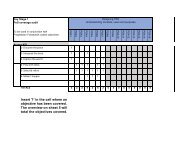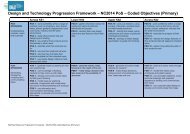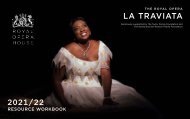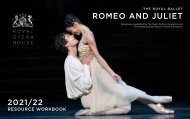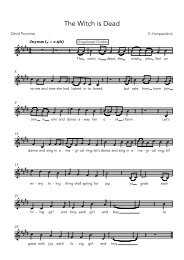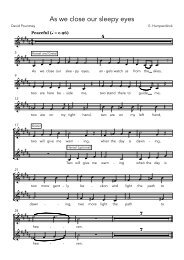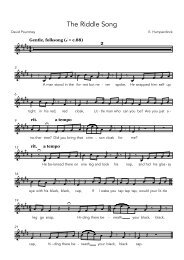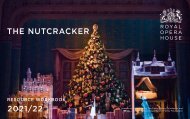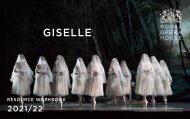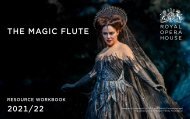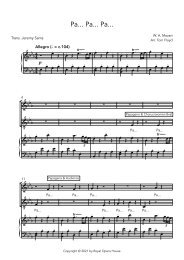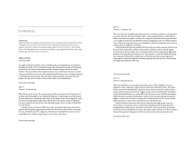National Nutcracker Lesson 7
Entrances and Exits. In this lesson explore transitions between scenes.
Entrances and Exits. In this lesson explore transitions between scenes.
Create successful ePaper yourself
Turn your PDF publications into a flip-book with our unique Google optimized e-Paper software.
THE CREATIVE CHALLENGE TASK<br />
As discussed at the INSET, you and your dancers<br />
are tasked with creating a dance of no more than<br />
five minutes based on one of the themes below<br />
from The <strong>Nutcracker</strong>:<br />
1. Visiting faraway lands<br />
2. Transformed by magic<br />
3. Let the battle commence<br />
The core focus of this activity is creative dance.<br />
We have made suggestions about the theme and<br />
the choice of music you might use to allow you to<br />
keep your focus on the development and creation<br />
of your dance. How you manage to develop your<br />
ideas in your dance will be the most important part<br />
of the assessment process.<br />
Midway through, you will submit footage of your<br />
dance so far to the Royal Opera House, with a<br />
brief description of how you have interpreted your<br />
chosen theme. You will then receive feedback<br />
from experts in the field to assist your class in<br />
their preparation for the final submission. This<br />
is also a good opportunity to ask for help on<br />
specific sections of your dance that you may need<br />
guidance/advice with.<br />
Depending upon how much class time and<br />
cross-curricular activity you choose to do, you may<br />
also consider:<br />
• Securing and booking a rehearsal space<br />
• Fitting rehearsal sessions into your school<br />
calendar<br />
• Costume design<br />
• Use of props<br />
• Building sets<br />
Staging your performance<br />
WHAT MAKES A GOOD DANCE<br />
LESSON STRUCTURE?<br />
Warm-up<br />
Creative exploration<br />
Performance<br />
Appreciation and reflection<br />
Cool down<br />
Questions you could ask your dancers after the<br />
lesson could include:<br />
• How did you feel at the beginning/middle/<br />
end of the lesson?<br />
• Which was your favourite part? Why?<br />
• Did you like (insert some example from<br />
the lesson) and if so, why?<br />
• How might we develop the ideas next time?<br />
• What do we need to improve?<br />
• What do you need to improve?<br />
Always include some of the ideas you have relating<br />
to your chosen themes in each warm-up and task.<br />
Record all the dances and moments of<br />
choreography that emerge during your session and<br />
allow yourself time to review it outside the session.<br />
Ask yourself these questions:<br />
• What looks good / what do you enjoy<br />
watching the most?<br />
• What did the children appear to enjoy the<br />
most?<br />
• Which dancers are emerging as particularly<br />
responsible and capable?<br />
Make a note of all these points as this will<br />
help you decide what to do in your<br />
subsequent sessions.<br />
We highly recommend that your class is given the<br />
opportunity to perform in front of a live audience<br />
at your school, as part of a school assembly or the<br />
Christmas show.<br />
PAGE 5
RESOURCES KEY<br />
Digital resource: <strong>National</strong><br />
<strong>Nutcracker</strong> film<br />
Look out for the Arts Award logo<br />
for parts of the programme that<br />
fit with Discover & Explore<br />
Your chosen theme<br />
Choreographic ideas, tasks for<br />
your chosen theme based on your<br />
INSET experience<br />
Music from The <strong>Nutcracker</strong> –<br />
found in the resources bank on<br />
The Royal Opera House website<br />
A means of capturing and<br />
reviewing the movement material<br />
created during the lesson<br />
Clear empty space, free of<br />
obstructions, such as school hall<br />
Children to wear PE kit and have<br />
bare feet for practical session<br />
Copies of ballet mime images<br />
Record of material created at<br />
previous four lessons<br />
Costumes<br />
PAGE 10
LESSON: ENTRANCES AND EXITS<br />
7<br />
LESSON OUTCOMES<br />
To respond to ROH<br />
feedback – using<br />
the suggestions<br />
to develop and<br />
refine the creative<br />
response.<br />
To develop the dancers’<br />
awareness of the whole<br />
dance, not just their<br />
role in it as they stay in<br />
character.<br />
To explore how<br />
transitions can be made<br />
between scenes and<br />
how the dancers interact<br />
with each other and their<br />
surroundings during<br />
transitions on and off<br />
stage.<br />
CREATIVE CHALLENGE PROGRESS<br />
This week you need to finalize the choice of music<br />
for your dance. Hopefully you will have had helpful<br />
hints and suggestions from the ROH team which<br />
will provide a focus for your work over the next few<br />
weeks.<br />
RESOURCES NEEDED FOR THE LESSON<br />
©ROH/Johan Persson, 2009
STARTER<br />
Watch Episode 7 with the class and ask the<br />
following questions:<br />
• What three things should you remember<br />
when you enter the stage?<br />
• What verb was used to describe how the<br />
Angels entered the stage?<br />
• What adjective was used to describe how<br />
the Snowflakes entered the stage?<br />
• Was the ‘stately’ entrance fast or slow?<br />
• What did it tell you about the character?<br />
WARM-UP<br />
When we dance we are performing to an audience<br />
so it is really important that each dancer is aware<br />
of where they are at every moment in the dance<br />
and also how they get there.<br />
Repeat the Stage Directions game from Week 4 or<br />
another warm-up relevant to your dance.<br />
CREATIVE EXPLORATION<br />
Target a section of movement from your dance<br />
and use some of the structural devices introduced<br />
in our INSET to organize the material. A reminder<br />
of some of the structural devices we used at the<br />
INSET:<br />
• Shadowing – a group of dancers perform a<br />
phrase, then either a solo dancer or another<br />
group mirror elements or fragments of the<br />
movement.<br />
• Allowing some dancers to be still – while<br />
others are performing their duets/trios/<br />
group work.<br />
• Thinking about the beginning, middle and<br />
end of the dance, repeat some familiar<br />
material from the beginning somewhere near<br />
the end. This creates consistency.<br />
• Make sure you are using a variety of duets,<br />
trios, group and unison phrases.<br />
Remember you don’t have to use all the dancers in<br />
the same space at the same time.<br />
It is also important to remember that not all the<br />
children need to be on stage all of the time so<br />
think about when you want them to enter and exit.<br />
Make sure you give the children cues either going<br />
by the music, or by an action of another performer<br />
in the group.<br />
You can have children entering from one place on<br />
the stage or from different sides to give it variety.<br />
After experimenting and rehearsing this, watch<br />
the whole dance as it stands and get feedback<br />
from the dancers. Remind them that they need to<br />
be aware of their character throughout the whole<br />
dance whether on stage or not.<br />
Play your music choices and either short-list a<br />
couple or make a decision as to the piece that<br />
will be used. Discuss ways of remembering the<br />
changes made to the dance with your dancers.<br />
COOL DOWN<br />
Complete the usual cool down. Encourage a<br />
discussion about your dance so far.<br />
TOP TIPS<br />
It is not expected that your class ‘company’ will be<br />
on stage the whole time. This means you will have<br />
to think about getting dancers in and out of the<br />
performance space with as little fuss as possible.<br />
Think about using static poses with some dancers<br />
to frame the action of others. For example, you<br />
may have five duets performing while ten dancers<br />
stand around them.





